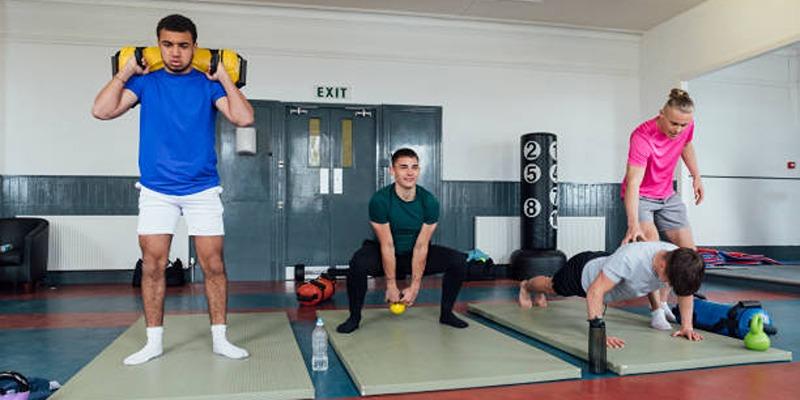Plyometrics for Beginners: 3 Explosive Exercises to Get You Started
Plyometric training or “jumping training” is an energetic exercise process that involves rapid or explosive movements in order to increase the force production and power to performance fitness. This kind of physical activity accelerates the movements which involves fast twitch muscles hence can be used to enhance agility among people of different fitness regimes. It might sound quite challenging at the beginning and hence beginners can begin with low impact exercises with the aim of strengthening the muscles, confidence as well as laying proper foundation.
What Is Plyometric Training?
Plyometric training is all about fast, powerful movements that activate your fast-twitch muscle fibers—the ones responsible for sharp bursts of speed and explosive power. Featuring dynamic exercises like jumping, bounding, and hopping, this training method is incredibly effective for developing explosive strength, speed, agility, and coordination.
Popular among athletes in sports such as basketball, soccer, and track and field, plyometric workouts are specifically designed to enhance performance in activities that demand quick, forceful movements.
Benefits of Plyometrics:
Before diving into specific exercises, let’s take a look at the key advantages of adding plyometrics to your fitness routine:
- Builds Strength and Power: Plyometric exercises engage multiple muscle groups simultaneously, helping to develop explosive strength and power.
- Boosts Athletic Performance: Widely used by athletes, plyometrics can improve speed, vertical jump, and reaction time.
- Burns Calories Effectively: Thanks to their high-intensity nature, plyometric workouts are great for torching calories and revving up your metabolism, making them a time-efficient way to stay fit.
- Enhances Coordination and Balance: Many plyometric movements demand precision and body control, which over time help improve your coordination and balance.
- Supports Cardiovascular Health: Plyometric training pushes your heart and lungs, building endurance and improving overall cardiovascular fitness.
Tips for Plyometric Beginners:
Starting with plyometrics? Follow these key tips to ensure a safe and effective workout:
- Warm Up Properly: Prepare your body with a thorough warm-up, including dynamic stretches and light cardio, to get your muscles and joints ready for explosive movements.
- Prioritize Technique: Focus on proper form over the number of repetitions.
- Start with the Basics: Begin with low-intensity exercises and progressively increase difficulty as your strength and confidence improve.
- Choose Joint-Friendly Surfaces: Perform jumps on forgiving surfaces like gym mats or grass to minimize stress on your joints.
- Take Rest Seriously: Allow sufficient recovery time between sets to maintain performance, prevent fatigue, and avoid overexertion.
3 Beginner Plyometric Exercises:

Plyometric training is a fantastic way to build explosive strength, improve endurance, and enhance athletic performance. If you're just getting started, these three beginner-friendly exercises will help you develop lower body power and control.
1. Jump Squats
Jump squats are a foundational plyometric exercise that targets your quadriceps, hamstrings, and glutes while boosting explosive power and cardiovascular fitness.
How to Perform:
- Stand with feet shoulder-width apart, toes slightly pointing outward.
- Lower into a squat, keeping your back straight, chest up, and knees aligned with your toes.
- Push through your heels to jump as high as possible, extending your arms upward to generate momentum.
- Land softly, returning immediately to the squat position by bending your knees deeply to absorb the impact.
- Perform 8–10 repetitions, increasing as your strength improves.
Tips:
- Keep your core engaged to maintain balance and control.
- Land gently and bend your knees to reduce strain on your joints.
- Focus on smooth, controlled jumps rather than speed.
2. Box Jumps
Box jumps are an excellent way to build explosive lower-body power, improve coordination, and boost athletic ability.
How to Perform:
- Select a sturdy box or platform about 12–18 inches high (adjust based on your comfort level).
- Stand facing the box, feet shoulder-width apart, arms relaxed at your sides.
- Slightly bend your knees, engage your core, and swing your arms forward to power your jump.
- Jump onto the box with both feet, landing softly with bent knees and your weight evenly distributed.
- Step down carefully, one foot at a time, and reset before repeating for 6–8 repetitions.
Tips:
- Start with a lower box height if you're new, and gradually increase as your confidence grows.
- Land softly with bent knees to minimize joint stress.
- Maintain an upright posture with your core activated throughout the movement.
3. Lateral Bounds
Lateral bounds are a dynamic exercise that strengthens the glutes, hamstrings, and calves while enhancing agility, balance, and lateral movement—skills essential for sports and daily activities.
How to Perform:
- Begin in a slight squat position with your feet together, knees bent, and arms ready to assist your movement.
- Push off your left foot and jump laterally to the right, landing softly on your right foot with a bent knee to absorb impact.
- Use your arms for balance and immediately push off with your right foot to jump back to the left.
- Continue alternating sides with controlled, fluid movements for 10–12 repetitions per side.
Tips:
- Land softly and quietly, focusing on smooth, controlled motions.
- Keep your chest lifted and core engaged to maintain balance.
- Begin with smaller jumps and gradually increase the distance as your strength and confidence grow.
How to Structure a Plyometric Workout?
For beginners, incorporating plyometric exercises 1–2 times per week is a great way to build explosive strength. Here’s an example of a balanced workout:
1. Warm-Up:
Begin with 5–10 minutes of light cardio paired with dynamic stretches to properly prepare your body and reduce the risk of injury.
2. Exercise Circuit:
- Jump Squats: Perform 3 sets of 8–10 repetitions to build lower-body power.
- Box Jumps: Complete 3 sets of 6–8 repetitions for explosive strength and coordination.
- Lateral Bounds: Do 3 sets of 10–12 repetitions per side to enhance agility and stability.
3. Cool Down:
Finish your session with 5–10 minutes of static stretching to improve flexibility and aid recovery.
Mistakes to Avoid When Doing Plyometrics:

- Skipping the Warm-Up: Jumping straight into plyometric exercises without proper preparation can significantly increase your risk of injury.
- Poor Technique: Incorrect form not only reduces the effectiveness of your workout but also places unnecessary strain on your joints.
- Overtraining: Plyometric exercises are highly intense—avoid overdoing it, especially when you're just starting out.
- Neglecting Recovery: Rest days are essential to allow muscles to recover and to prevent overuse injuries.
Conclusion:
Plyometric training is an excellent way to build explosive power, enhance agility, and elevate your overall fitness. By beginning with beginner-friendly movements like jump squats, box jumps, and lateral bounds, you can safely develop the strength and skills needed to progress to more advanced exercises.












